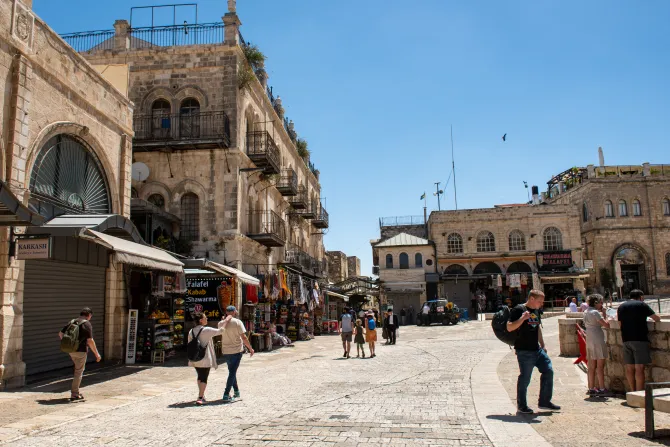By Marinella Bandini
The holy sites and the streets of the Old City are usually crowded with tourists and pilgrims at this time of year, but they have been empty for the past eight months due to the Israel-Hamas war.
Muslims orderly make their way to the entrances of the Al-Aqsa mosque compound for noon prayer, but otherwise, the Via Dolorosa is completely empty. There are no pilgrims ascending to the Holy Sepulcher. The Sanctuary of the Flagellation, maintained by the Franciscans at the starting point of the Via Crucis path, is always open — but that is empty, too.
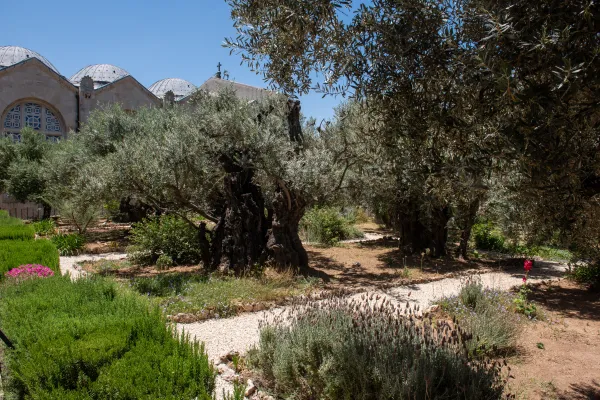
Things aren’t any better at Gethsemane.
“Before the war, we had more than a hundred groups a day. Today, we welcome two or three groups on a good day,” Brother Siniša Srebrenović, the guardian of the Franciscan Convent of the Agony (Gethsemane), told CNA. “They mostly come from Asia or South America. Some come from Eastern Europe, mainly Orthodox Christians.”
The absence of pilgrims also means the absence of income.
“We friars sustain ourselves with the offerings of the pilgrims. The charity of the pilgrims also helps cover the maintenance expenses of the sanctuary and some development projects,” Srebrenović explained. “Today, everything is at a standstill. Workers from the Palestinian Territories do not have permission to come, and the financial resources are only enough for the ordinary. Despite this, the custody continues to financially support its workers and has not laid off any of them.”
At the Holy Sepulcher, the waiting time to enter the edicule (where Jesus’ tomb is kept) is just a few minutes, compared with up to two hours last year. The daily procession of the Franciscan friars inside the basilica is attended by only a handful of faithful — mostly residents of Jerusalem.
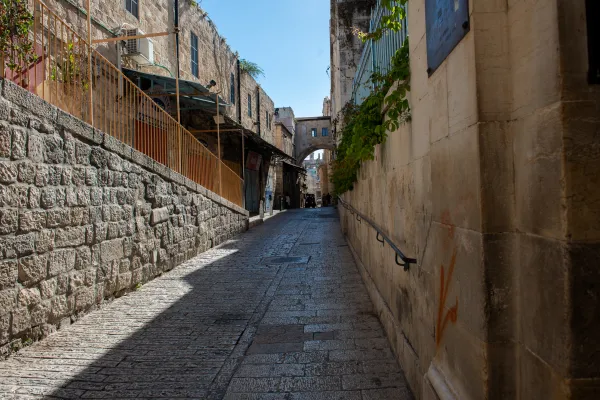
Even Bethlehem is empty
“Tourism in Palestine is effectively zeroed out. Every day we lose $2.5 million,” lamented Majed Ishaq, director general of the marketing department of the Ministry of Tourism and Antiquities of Palestine.
He described to CNA a dramatic situation: “Tourist facilities are closed; people working in the sector — including many Christians — have had no income for months. People are trying to sell houses, cars, furniture, to survive.”
“International tourism passes through Israel; they control our borders. We are under a kind of siege,” Ishaq continued. “Reaching Bethlehem is still possible, but cities in the north, like Nablus or Jenin, and also Hebron further south, are almost unreachable. Even local tourism and internal travel are severely affected due to attacks by settlers.”
Some groups arrive, especially via Jordan. The hope is that something will move at least by the end of the year, especially for the Christmas holidays.
According to data from the Israeli Ministry of Tourism, just over 80,000 people (tourists and pilgrims combined) entered the country in April — a decrease of 77% compared with April 2023 and 80% compared with April 2019, the peak year before the pandemic.
Cumulatively, from January through April, about 285,000 tourist arrivals were recorded, a decrease of about 78% in relation to the corresponding period in 2023.
“The decline is attributed to the impact of the ‘Iron Swords’ war [the name Israel has given to the campaign against Hamas in the Gaza Strip following the events of Oct. 7, 2023] although in the months that have passed since the outbreak of the war, there has been a certain increase in the number of tourist arrivals to Israel, but it is not yet possible to identify any trend.”
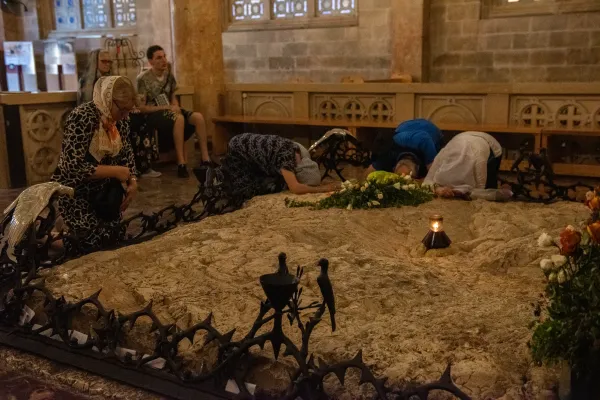
Dr. Yaron Ergas, director of research, statistics, and information management at the Israeli Ministry of Tourism, told CNA that “the Ministry of Tourism conducts a survey among incoming tourists, where they are asked several questions including the main purpose of their visit. Tourists choosing ‘pilgrimage/faith based tour’ are considered religious tourists. That percentage, in 2019, was 16.6%” out of about 5 million entries.
At the outbreak of the war, in October 2023, “we stopped the surveys,” Ergas explained, so there is no useful data on religious tourism since then.
“Recovery is not expected until late 2025,” he added.
Other statistics, focused on Christian pilgrims, were provided to CNA by the Christian Information Centre (CIC), sponsored by the Custody of the Holy Land. CIC has been providing information about Christianity and on the Holy Land, including shrines, holy places, and liturgies, for more than 50 years. Additionally, it is the only official channel for booking Masses in the holy sites.
From October to December 2023, approximately 2,800 groups (107,000 individuals) had booked at least one celebration through the CIC, and they all canceled as soon as the war broke out. Of these, 95% were Catholics and 4% were Protestants. Ninety percent were groups from abroad. From January to April of this year, the groups registered by the CIC ranged from 100 to 200 per month (averaging 5,000 to 6,000 individuals per month).
The lack of Christian pilgrims in the Holy Land is especially due to the fact that many companies are unwilling to issue insurance policies for those heading to a territory considered dangerous and risky.
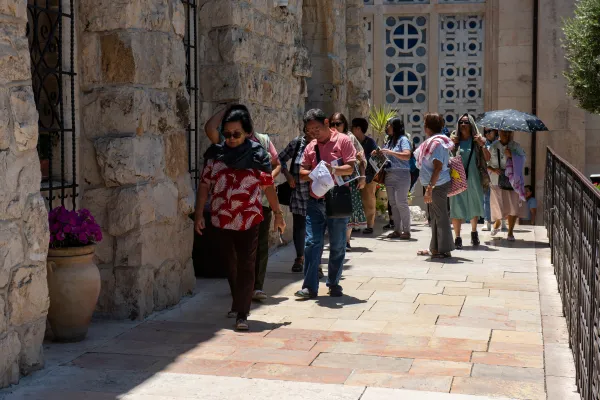
Arrivals from Southeast Asia and South America continue, however (while the United States remains the top country for entries, the second group surprisingly comprises Indonesians). This is largely due — as the pilgrims themselves admit — to the fact that agencies do not refund prepaid trips, which many have invested their life savings in. This compels people to travel despite everything.
“We want to encourage Jews and Christians leaders to push their believers to come on a pilgrimage to the Holy Land. We assume, and I think it is correct, that there’s a desire to come and visit,” Pini Shani, deputy director general and head of marketing administration of the Israel Ministry of Tourism, shared with CNA.
Hopes for the 2025 Jubilee
In 2025 there will be two interesting events for religious tourism in the Holy Land.
“A special exhibition of the Isahia scrolls will be held in 2025 at the Israel Museum to commemorate its 60th anniversary. We are confident that many people will show interest. We will try to engage people who come on pilgrimage to the Holy Land to visit this special exhibition,” Shani said.
Furthermore, in 2025, Catholics will celebrate a jubilee year.
“We were very encouraged by the pope’s call for the jubilee,” Shani said. “The churches of the Holy Sepulcher in Jerusalem, the Annunciation in Nazareth, and the Nativity in Bethlehem will be jubilee places; people will be encouraged to visit them, and we’re sure it will help to recover tourism.”
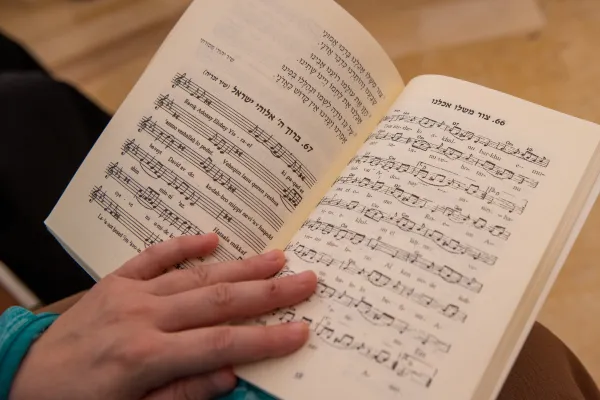
The main Christian religious leaders in the Holy Land have never stopped issuing appeals to pilgrims to return to the holy places. “Do not be afraid, return to Jerusalem and to the Holy Land! Your presence is always a presence of peace, and we sincerely need peace today; may you come and bring us your peace,” said the Latin patriarch of Jerusalem, Cardinal Pierbattista Pizzaballa, at the end of the Palm Sunday procession.
An echo of those words is found in the message released by the Dicastery for Evangelization on May 28, on the occasion of the 45th World Tourism Day, to be held on Sept. 27 on the theme “Tourism and Peace.”
“The interest that moves millions of tourists can easily be linked with the commitment to brotherhood, so as to constitute a network of ‘messengers of peace’ who speak to the entire world to invoke the end of all war and the reopening of territories full of history, culture, and faith. … Being peace-builders is not only possible; it is required of those who embark on a journey,” the dicastery’s message said.
Born and raised in Italy, Marinella Bandini has been a professional journalist since 2008. She works for several news agencies and online newspapers in the Catholic space. Currently based in Jerusalem, she collaborates with the Custody of the Holy Land

